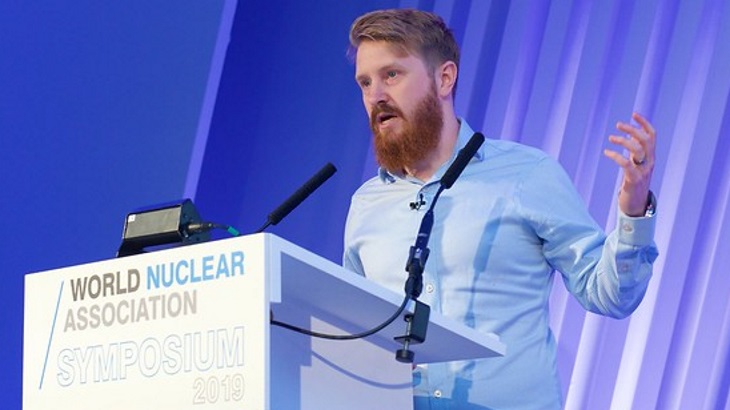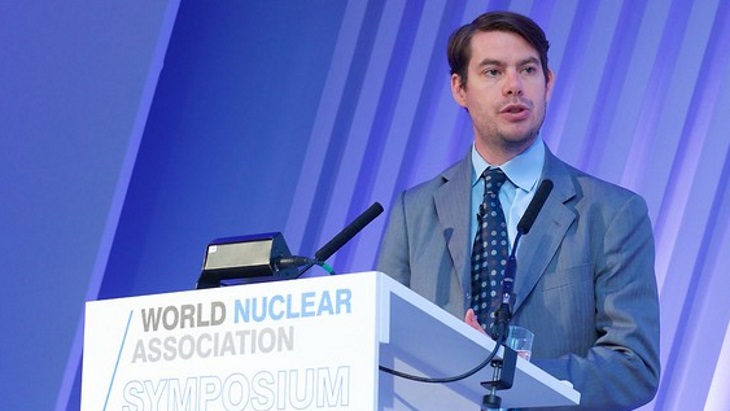Brent Wanner, the IEA's head of power generation analysis, described the findings of its report Nuclear Power in a Clean Energy System published in May.
"The IEA is an all-fuels, all-technologies agency, which means we don't have a horse in the race," Wanner said. "But there's quite a lot of misinformation out there and if you ask a general audience what the contribution of nuclear power is, they would not be close to the right number."
Sama Bilbao y León, the NEA's head of nuclear technology development and economics, presented the findings of its report The Costs of Decarbonisation: System Costs with High Shares of Nuclear and Renewables published in January.
"All low-carbon fuels will be needed to help meet climate goals, but the system costs of renewables need to be taken into account if there is to be a level playing field for nuclear power," she said. "And markets need to be designed so that they send signals to encourage investors to invest in low-carbon energy sources."
They were joined with the message about system costs by Staffan Qvist, director of Qvist Consulting. He is just completing a study on the Swedish electricity system - "one of the easiest countries in the world to transition to 100% renewable energy due to its strong hydroelectric sector" - which concludes that nuclear energy remains an integral part of the lowest cost systems (alongside renewables like hydroelectricity and wind power) and there is a need for a market design that reflects nuclear power's attribute regarding system costs.
"With the system cost argument established, there then needs to be a market design that allows low-carbon electricity producers a return on investments, and policies to lower the weighted average cost of capital [WACC] in new nuclear projects," he said, adding that an effective potential example of this may be the UK's proposed regulated asset base (RAB) model.
What are system costs?
In its report, the NEA says the notion of system costs - that in the presence of uncertain and variable electricity generation the total costs are more than the sum of plant-level costs as calculated with the levelised cost of electricity methodology - has thus far been "somewhat of a novelty". Together with its sister agency, the IEA, it has learned that in the electricity systems of the future, all available low-carbon generation options - nuclear energy, wind, solar photovoltaic, hydroelectricity and, perhaps one day, fossil fuels with carbon capture, utilisation and sequestration - will need to work together in order to enable countries to meet their environmental goals in a cost-efficient manner.
VRE, however, are not yet fully competitive with nuclear power on the metric of system costs. A cost-effective low-carbon system would therefore probably consist of a sizeable share of VRE, an at least equally sizeable share of dispatchable zero-carbon technologies such as nuclear energy and hydroelectricity, and a residual amount of gas-fired capacity to provide some added flexibility alongside storage, demand side management and the expansion of interconnections.
Focus on nuclear
Wanner noted that nuclear power provides 10% of global electricity generation and is the second largest low-carbon source of electricity in the world today, after hydropower. Its share is larger than wind, bioenergy and solar combined. The use of nuclear power over the last 50 years has avoided the emission of 60 gigatonnes of CO2, he said, adding that, without nuclear, CO2 emissions would have been 20% higher.
"Many nuclear power plants in advanced economies are facing retirement as they approach the end of their original 40-year design lifetime. Nuclear lifetime extensions are cost-competitive with new solar and wind, and provide a dispatchable source of clean electricity. A lifetime extension costs just over USD1 billion per gigawatt to extend for 20 years and gives a levelised cost of about USD50 per megawatt hour, which in the United States is very similar to new gas-fired capacity. There's an even stronger case in the European Union and in Japan. We should take advantage of this low-cost source of green electricity," he said.
Without additional lifetime extensions or new projects, nuclear capacity in advanced economies would decline by two-thirds by 2040, he said. "We need to raise awareness to policymakers that there is a potential risk if there is complacency and nuclear is left out of the group of low-carbon solutions."
The implications of fading nuclear power in advanced economies are, he said, higher bills for consumers (by as much as 15% by 2030 and 30% by 2040 in countries that rely most heavily on nuclear power) and higher CO2 emissions (over the next two decades, there would be an additional 4 billion tonnes from electricity generation).
Bilbao y León highlighted the lack of progress in the transition to clean energy. "Low-carbon sources of energy provided 36% of power generation last year, which is exactly the same as 20 years ago and is despite the fact that we all have the perception that clean generation is growing. It’s because we have allowed our nuclear fleet to decline," she said.
The Paris climate agreement implies a 50 gCO2/kWh target, she noted, which is intended to hold the increase in global average temperature to well below 2 degrees. "The current carbon intensity of electricity is 570 gCO2/kWh and the target is 50 gCO2/kWh or less. That is a huge challenge," she said. "Electricity contributes 40% of global CO2 emissions and will play a key role. Actual emissions from electricity will need to decline by 73% globally and by 65% in OECD countries."
The actual cost of electricity should reflect not only plant-level generation costs, such as for concrete, steel, fuel and human resources for the power plants, but also grid-level system costs, which are the costs that different forms of generation impose on the system in bringing electricity to the customer, and also the social and environmental costs, such as emissions, air quality, and security of supply, she said.
"Total system costs are the sum of plant-level generation costs and grid-level system costs and are mainly due to characteristics intrinsic to variable generation," she said. "Our study shows that in future energy markets we are going to see a large penetration of renewable energy sources and our systems will become prohibitively inefficient."

It's always nuclear
Qvist is due to publish a comprehensive new study later this autumn on future low-carbon electricity system options for Sweden. According to government agency Statistics Sweden, nuclear energy was the largest electricity producer in 2018 with 66 TWh, followed by hydroelectricity (61 TWh) and wind power (17 TWh).
The country has eight nuclear power reactors, but in 2015 government decisions to raise a targeted anti-nuclear tax prompted utilities to close four reactors by the end of 2020, two of which are already being decommissioned. The anti-nuclear tax has since been removed and, as a result, state-owned Vattenfall is shutting down two reactors that are currently profitable, Qvist said.
"We are actively decommissioning 25 to 35-euro per megawatt hour of firm capacity and building 40 to 50-euro per megawatt hour of variable production. That Sweden is not thoroughly exploring the options that would make it possible for Vattenfall to invest in long-term operation of these reactors is a policy failure and we need to address this."

Qvist's study identifies the cost-optimal generation mix with 20 different production and storage technology options and constraints on emissions. It uses a modified and expanded version of the GenX code developed by the Massachussetts Institute of Technology Energy Initiative and used in modelling for the report The Future of Nuclear Energy in a Carbon-Constrained World, which was published in September last year. The most cost-effective systems include all possible long-term operation of existing nuclear with all examined variations of input, Qvist said.
"If you run a very large variation of input of how cheap solar can become, how cheap wind, batteries, hydrogen storage, demand-side flexibility, whatever, it always says 'keep investing in existing nuclear'. If it does that in one the easiest systems to transition to 100% renewables, then it will do it probably in every other system that we could ever look at. It always picks long-term operation," he said. "There is a need therefore to come up with a market design that reflects this attribute of nuclear power regarding system costs.”
On new nuclear build, he said: "With the system cost argument and logic established, we need to suggest policies to lower the weighted average cost of capital. The regulated asset base model could prove to be a way forward on this … At low WACC, new nuclear takes a significant share of the lowest total cost system in nearly every market."
RAB model
The UK government's public consultation on its assessment of a RAB model ends on 14 October. The review is aimed at reducing the cost of new nuclear power plant projects by having consumers pay upfront through their energy bills. A solution is needed urgently because nuclear energy is seen as a vital part of the government's commitment to cutting the country's carbon emissions to net zero by 2050. Seven of the UK's eight existing nuclear plants are set to be retired by 2030.
Chris Bowbrick, deputy director of nuclear generation policy at the UK Department for Business, Energy and Industrial Strategy, said there had been a lot of interest in the review, including from overseas.

"There's a real air of optimism," he said. "We've had really good feedback internationally; from colleagues who are looking at what the UK is doing and at whether this is a solution that can be rolled out across the world." The consultation has also attracted interest from "not the typical sorts of investors you would normally associate with nuclear projects", he added.
The RAB model would not apply to Hinkley Point C, which is currently under construction by EDF Energy in Somerset, England, but would apply to future plants. As many as five more new-build projects have been planned - by EDF Energy together with China General Nuclear; NuGeneration (NuGen); and Horizon Nuclear Power.
In November last year, Toshiba Corp announced it was scrapping its nuclear new-build project at Moorside and would wind up its subsidiary managing the project, NuGen. Ownership of the Moorside site reverted back to the Nuclear Decommissioning Authority. Bowbrick told last week's Symposium 2019 that the government is "thinking what we want to do with that site and we’ll make a decision on that in due course."
Early this year, Horizon's new-build projects were suspended even though the UK subsidiary of Japan's Hitachi had made substantial progress with its plans to provide at least 5.4 GWe of new capacity across two sites - Wylfa Newydd, in north Wales, and Oldbury-on-Severn, in southwest England - by deploying Hitachi-GE's UK advanced boiling water reactors.
Bowbrick said other sites earmarked for development of nuclear power plants, apart from Moorside but including Wylfa Newydd and Oldbury, are still owned by their developers.





_47120.jpg)
_23621.jpg)

_63865.jpg)





